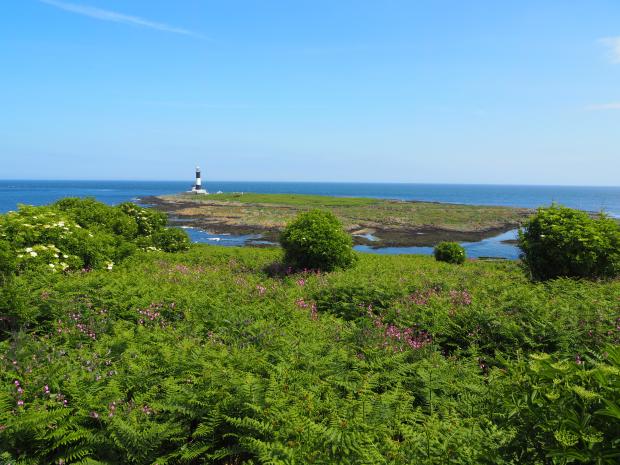
Copeland Islands ASSI is located off the County Down coast and comprise Big Copeland, Light House Island and Mew Island. The islands are important sites for breeding seabirds and waders, in addition to their coastal plant communities and geological features.
Big Copeland supports the most diverse range of habitats of the three islands. Communities influenced by the sea are found around the shore with maritime cliff vegetation and pockets of saltmarsh also present. The centre of the island is occupied by semi-improved wet grassland with frequent areas of marsh.
The vegetation on Light House Island consists of short rabbit grazed turf with large areas of rank bracken and Himalayan balsam. Notable species include English stonecrop, rock sea-spurrey, Scots lovage and sea purslane. Light House Island represents the southern limit for Scots lovage in Europe and the northern limit for sea purslane in Ireland.
Mew Island is dominated by rank stands of grass and bracken but, as on all the islands, notable areas of inter-tidal and exposed rock habitat are present.
The islands are internationally important sites for breeding populations of Manx shearwater and Arctic tern and nationally important sites for breeding Mediterranean gull, common gull and eider duck.
The rabbit populations on the islands play an important role in the breeding success of the Manx shearwater as the latter mainly nest in the rabbit burrows that honeycomb the islands. Grazing by rabbits maintains a short sward, which is desirable for the fledglings.
Big Copeland has an internationally important Arctic tern colony. The site now represents the largest colony for this species in Ireland. Mew Island has been an important tern colony in the past and it is hoped that positive management will encourage terns to become re-established.The islands are the most important breeding sites in Northern Ireland for common gull.
Big Copeland has recently held Northern Ireland's first successful breeding pair of Mediterranean gull.
The islands are home to a nationally important population of breeding eider duck. Non- breeding eider form part of the nationally important population that occurs along the Outer Ards coast and Belfast Lough areas.
Other breeding colonies of note include black guillemot, water rail and stock dove. The latter species has suffered a dramatic decline in Northern Ireland, but numbers have increased on Copeland.
Breeding waders such as lapwing and snipe may be found further inland. Here the taller vegetation, interspersed with open areas, provides an ideal breeding habitat.
Birds of prey favour the islands when the breeding season is over. Hen harrier, sparrowhawk, buzzard, kestrel, merlin and peregrine are all seen regularly.
Grey and common seals can be found off the Copeland Islands in significant numbers. They utilise the off-shore islands and reefs as haul-outs and as pupping and mating sites. It is very important to conserve for the future the best features that remain. We (NIEA) aim to work with landowners and occupiers to ensure that special landscape features from our past and habitats and species, like those at Copeland Islands, are protected for the future through ASSI designation.
Related articles
- ASSI Guidance for Public Bodies/Competent Authorities
- Coastal Areas of Special Scientific Interest
- Conservation Management Plans (CMPs)
- European Marine Sites - Marine Special Areas of Conservation and Special Protection Areas
- Introduction to Conservation Management Plans (CMPs) for Northern Ireland’s Special Areas of Conservation
- Marine Conservation Zones
- Marine Protected Areas
- Marine Ramsar sites
- Portrush Coastal Zone
- Special Areas of Conservation
- Special Areas of Conservation for Harbour porpoise
- Special Protection Areas
